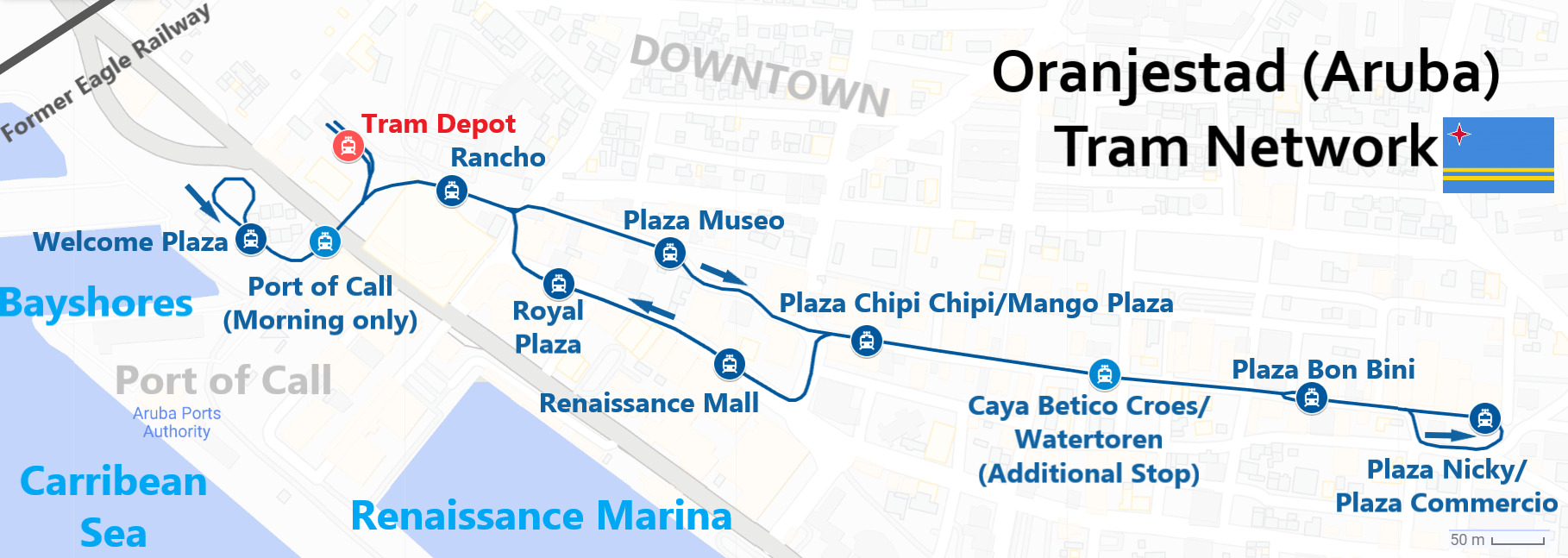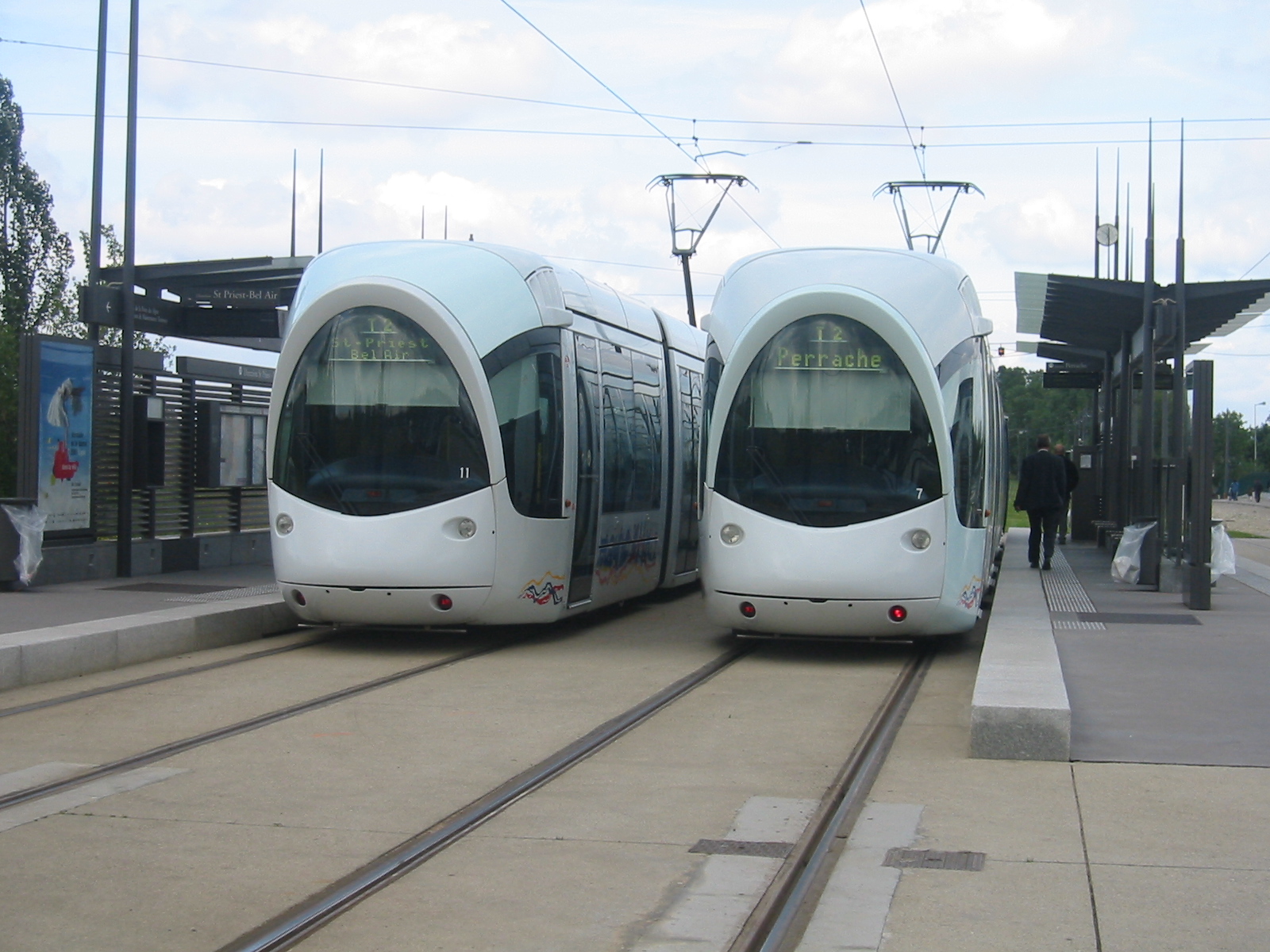|
Trams In Oranjestad, Aruba
The Oranjestad Streetcar () and (Papiamento: ''Tranvia Oranjestad)'' is a single-track tram line in Oranjestad, the capital city of Aruba. It is owned and operated by Arubus, the national public transportation company.Morrison, Alle"The Streetcars of Oranjestad, Aruba" (tramz.com)/ref> It was built as a key component of a larger project to upgrade the main retail areas of the town, other aspects of which included pedestrianization of streets, planting of trees, installation of ornamental street lighting and resurfacing of streets and sidewalks."Aruba tramway drives major street redevelopment" (July 2013). ''Tramways & Urban Transit'', p. 279. UK: LRTA Publishing. . History The line is the first and so far the only passenger rail service on the island and the rest of the Dutch Caribbean. Three industrial railways had been constructed on the island, but have all closed. It was inaugurated on 22 December 2012, seven days after the arrival of the first single-deck car. Regular serv ... [...More Info...] [...Related Items...] OR: [Wikipedia] [Google] [Baidu] |
Track (rail Transport)
Railway track ( and UIC terminology) or railroad track (), also known as permanent way () or "P way" ( and Indian English), is the structure on a railway or railroad consisting of the rails, fasteners, sleepers ( railroad ties in American English) and ballast (or slab track), plus the underlying subgrade. It enables trains to move by providing a dependable, low-friction surface on which steel wheels can roll. Early tracks were constructed with wooden or cast-iron rails, and wooden or stone sleepers. Since the 1870s, rails have almost universally been made from steel. Historical development The first railway in Britain was the Wollaton wagonway, built in 1603 between Wollaton and Strelley in Nottinghamshire. It used wooden rails and was the first of about 50 wooden-railed tramways built over the subsequent 164 years. These early wooden tramways typically used rails of oak or beech, attached to wooden sleepers with iron or wooden nails. Gravel or small stones were pa ... [...More Info...] [...Related Items...] OR: [Wikipedia] [Google] [Baidu] |
Aruba Bank
Aruba, officially the Country of Aruba, is a constituent island country within the Kingdom of the Netherlands, in the southern Caribbean Sea north of the Venezuelan peninsula of Paraguaná and northwest of Curaçao. In 1986, Aruba became a constituent country within the Kingdom of the Netherlands and acquired the formal name the Country of Aruba. Aruba has an area of . Aruba measures in length from its northwestern to its southeastern end and is across at its widest point. Aruba is geologically located in South-America, lying on the South-American continental shelf. Alongside Bonaire and Curaçao, Aruba forms a group referred to as the ABC islands. The Dutch Caribbean encompasses the ABC islands along with the other three substantial islands, the SSS islands. In contrast to much of the Caribbean, which experiences humid tropical climates, Aruba has a dry climate with an arid xeric landscape. The relatively warm and sunny weather persists throughout the year. With a popula ... [...More Info...] [...Related Items...] OR: [Wikipedia] [Google] [Baidu] |
National Archaeological Museum Aruba
The National Archaeological Museum Aruba () is an archaeological museum in the city of Oranjestad in Aruba. The collections cover from 2500 BCE to the 19th century. () In 1981, the Archaeological Museum of Aruba was opened. In 2009, the museum had moved to a new location and was reopened as the National Archaeological Museum Aruba. See also * List of museums in Aruba * A.J. van Koolwijk Antonius Johannes van Koolwijk (Winssen, 9 October 1836 – Hees (Nijmegen), Hees, 1913) was a Dutch clergyman of the Roman Catholic Church. His notable contributions lie in the field of archeological research, particularly his studies on the ind ... References External links * * 1981 establishments in Aruba Archaeological museums Museums established in 1981 Museums in Aruba Monuments of Aruba Buildings and structures in Oranjestad, Aruba 20th-century architecture in the Netherlands {{Caribbean-museum-stub ... [...More Info...] [...Related Items...] OR: [Wikipedia] [Google] [Baidu] |
Oranjestad Bus Terminal
{{geodis ...
Oranjestad may refer to: * Oranjestad, Aruba, the capital of Aruba * Oranjestad, Sint Eustatius, until 10 October 2010 part of the Netherlands Antilles, now part of the Netherlands * City with a strong connection to the House of Orange-Nassau, particularly members of the Unie van Oranjesteden (Union of Orange Cities): ** Breda, Netherlands ** Buren, Netherlands ** Diest, Belgium ** Dillenburg, Germany ** Orange, Vaucluse, France ** Steenbergen, Netherlands See also * Orange City (other) Orange City may refer to: * Orange City, Florida, United States * Orange City, Iowa, United States * City of Orange, New Jersey, United States * Orange, California, United States * Orange, Vaucluse, France * Nagpur, Maharashtra, India, nicknamed "O ... [...More Info...] [...Related Items...] OR: [Wikipedia] [Google] [Baidu] |
Logo Arubus
A logo (abbreviation of logotype; ) is a graphic mark, emblem, or symbol used to aid and promote public identification and recognition. It may be of an abstract or figurative design or include the text of the name that it represents, as in a wordmark. In the days of hot metal typesetting, a logotype was one word cast as a single piece of type (e.g. "The" in ATF Garamond), as opposed to a ligature, which is two or more letters joined, but not forming a word. By extension, the term was also used for a uniquely set and arranged typeface or colophon. At the level of mass communication and in common usage, a company's logo is today often synonymous with its trademark or brand.Wheeler, Alina. ''Designing Brand Identity'' © 2006 John Wiley & Sons, Inc. (page 4) Etymology Douglas Harper's ''Online Etymology Dictionary'' states that the first surviving written record of the term 'logo' dates back to 1937, and that the term was "probably a shortening of logogram". History Numerous ... [...More Info...] [...Related Items...] OR: [Wikipedia] [Google] [Baidu] |
Aiga Bus Inv
The American Institute of Graphic Arts (AIGA) is a professional organization for design. Its members practice all forms of communication design, including graphic design, typography, interaction design, user experience, branding and identity. The organization's aim is to be the standard bearer for professional ethics and practices for the design profession. There are currently over 25,000 members and 72 chapters, and more than 200 student groups around the United States. In 2005, AIGA changed its name to “AIGA, the professional association for design,” dropping the "American Institute of Graphic Arts" to welcome all design disciplines. History In 1911, Frederic Goudy, Alfred Stieglitz, and W. A. Dwiggins came together to discuss the creation of an organization that was committed to individuals passionate about communication design. In 1913, president of the National Arts Club, John G. Agar, announced the formation of The American Institute of Graphic Arts during the eighth an ... [...More Info...] [...Related Items...] OR: [Wikipedia] [Google] [Baidu] |
Port Of Oranjestad
Paardenbaai (English: ''Bay of Horses'') or Port of Oranjestad is the main seaport for passengers in Aruba. It is located in Oranjestad and has existed since 1796. History In 1796, Fort Zoutman was constructed near Paardenbaai. It was a natural bay which was accessible to large ships. It was the second harbour on Aruba after Commandeurs Baai (Commander's Bay) in Savaneta. The bay later became known as Paardenbaai (Bay of Horses) because the harbour was mainly used to ship horses to Jamaica and other places. The village near the harbour had no name and was often referred to as Paardenbaai. In 1820, it was named Oranjestad. In the 1920s, a part of the harbour was reclaimed to extend the city of Oranjestad. With this, the harbour is now partially located in Taratata. In 1928, Arend Petroleum Maatschappij, a subsidiary of Royal Dutch Shell, opened an oil refinery near the harbour. A wharf at the Taratata was used for the refinery, but turned out to be too small, therefore, a 420 me ... [...More Info...] [...Related Items...] OR: [Wikipedia] [Google] [Baidu] |
Aiga Watertransportation Inv
The American Institute of Graphic Arts (AIGA) is a professional organization for design. Its members practice all forms of communication design, including graphic design, typography, interaction design, user experience, branding and identity. The organization's aim is to be the standard bearer for professional ethics and practices for the design profession. There are currently over 25,000 members and 72 chapters, and more than 200 student groups around the United States. In 2005, AIGA changed its name to “AIGA, the professional association for design,” dropping the "American Institute of Graphic Arts" to welcome all design disciplines. History In 1911, Frederic Goudy, Alfred Stieglitz, and W. A. Dwiggins came together to discuss the creation of an organization that was committed to individuals passionate about communication design. In 1913, president of the National Arts Club, John G. Agar, announced the formation of The American Institute of Graphic Arts during the eighth an ... [...More Info...] [...Related Items...] OR: [Wikipedia] [Google] [Baidu] |
Train Depot
A train station, railroad station, or railway station is a Rail transport, railway facility where trains stop to load or unload passenger train, passengers, freight rail transport, freight, or both. It generally consists of at least one railway platform, platform, one Railway track, track, and a station building providing such ancillary services as train ticket, ticket sales, waiting rooms, and baggage/freight service. Stations on a single track (rail), single-track line often have a passing loop to accommodate trains travelling in the opposite direction. Locations at which passengers only occasionally board or leave a train, sometimes consisting of a short platform and a waiting area but sometimes indicated by no more than a sign, are variously referred to as "stops", "flag stops", "#Halt, halts", or "provisional stopping places". The stations themselves may be at ground level, underground, or elevated. Connections may be available to intersecting railway line, rail lines or o ... [...More Info...] [...Related Items...] OR: [Wikipedia] [Google] [Baidu] |
Tram Stop
A tram stop, tram station, streetcar stop, or light rail station is a place designated for a tram, streetcar, or light rail vehicle to stop so passengers can board or alight it. Generally, tram stops share most characteristics of bus stops, but because trams operate on rails, they often include railway platforms, especially if stepless entries are provided for accessibility. However, trams may also be used with bus stop type flags and with mid-street pavements as platforms, in street running mode. Types of tram stops Tram stops without platforms Many tram or streetcar stops, especially on older tram lines street-running on narrower streets, have no dedicated platforms. Instead, stops are located in the middle of the roadway. Passengers need to cross lanes for motor vehicles to board or alight from trams. Examples of systems with this type of stops include: North America * Toronto, ON, Canada: Most stops on all Toronto streetcar system, TTC streetcar routes except 509, 51 ... [...More Info...] [...Related Items...] OR: [Wikipedia] [Google] [Baidu] |




